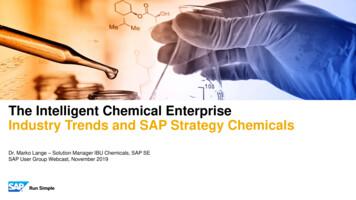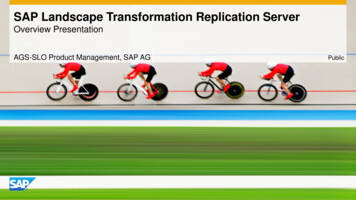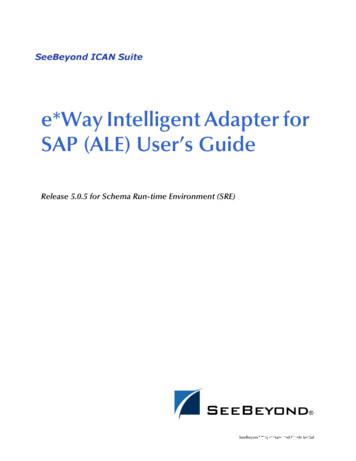Introduction To SAP Records Management For Public Sector
Introduction to SAP RecordsManagement for Public SectorApplies to:SAP Records Management for Public Sector.SummaryThis article gives an overview of the SAP records management for Public Sector. It introduces some termsspecific to public sector and also offers a step by step guide to some important customizing relevant forRecords management for public sector (TNA specific).Author:Poonam AssudaniCompany: SAP Labs IndiaCreated on: 04 March 2010Author BioPoonam Assudani is working with the SAP Labs India for the past 3.5 years .She is working asSenior Consultant - Development with SAP Custom Development team which offers customizedsolutions to customers.SAP COMMUNITY NETWORK 2010 SAP AGSDN - sdn.sap.com BPX - bpx.sap.com BOC - boc.sap.com UAC - uac.sap.com1
Introduction to SAP Records Management for Public SectorTable of ContentsIntroduction . 3Important Entities in Public Sector Records Management: . 4RMS ID . 4Records: . 4Records model: . 5Record Plan /File Plan: . 5Records and Case Management standard the National Archives (TNA) . 5Customizing . 6Setting up Generation Rules . 6Case Indicators . 6Assign Generation Rules . 7Create Generation Profile . 7Assign Generation Profile . 7Creation of Disposal Rule . 8Creation of File Plan and Class . 8Creation of Record model (Case Container) . 10Creation of Record model (record model). 12Related Content . 13Copyright. 14SAP COMMUNITY NETWORK 2010 SAP AGSDN - sdn.sap.com BPX - bpx.sap.com BOC - boc.sap.com UAC - uac.sap.com2
Introduction to SAP Records Management for Public SectorIntroductionThis document aims at providing basic understanding of the SAP Records Management for Public Sector.The Document assumes basic understanding of the SAP systems in general and understanding of the SAPRecords Management in general.SAP PSRM is the union of Records management and Case Management with some additional features forpublic sector.The goal of the PSRM is to manage business process related documents in accordance with the publicsector laws, rules and practices.SAP PSRM is certified in accordance with the following standards: DOMEA (GERMANY) TNA (UK)Below are the solution components for PSRM1. Content Management: Storing records/case/document in electronic format.2. Incoming mail processing: Using this process, you can enter incoming documents (e-mail, faxes, andscanned documents) electronically in the incoming post book and forward them to the responsibleprocessor.3. Information retrieval: Classification of records/cases/documents by keywords and fileplan.4. Workflows: Approval and decision making process.5. Retention and disposal: Using this process, you can transfer completed cases and documents thatare no longer required to the central archive.Cases that do not have to be stored in the central archive can be deleted from the system once theirretention period expires.6. Cross – Departmental information exchange : Printing, emailing records/cases/documents7. Integration into SAP for public sector: Integration to grant management, Funds management , taxand revenue integration8. Security: Digital signature for documents.Electronic Desk: You call the PSRM electronic desk using the transaction ‘SCASEPS’.SAP COMMUNITY NETWORK 2010 SAP AGSDN - sdn.sap.com BPX - bpx.sap.com BOC - boc.sap.com UAC - uac.sap.com3
Introduction to SAP Records Management for Public SectorImportant Entities in Public Sector Records Management:RMS IDAn RMS is a discrete unit within Records Management. The RMS divides various business units logically.Dividing the records of a company into discrete units means that is it possible to provide particular groups ofusers with access to particular records.1. Example: In a hospital there are personnel records and patient records. Employees in the personneldepartment only have access to the "RMS for personnel records"; nurses and doctors only have accessto the "RMS for patient records".2. RMS is a classification parameter of the area S AREA RMS. You assign values to this parameterusing the Customizing activity Maintain Registry. You separate the different RMSs by assigning elementtypes to one or more RMS. An RMS can contain any number of element types. Elements can only bedisplayed in the RMS in which they have been entered.Records:Records are represented in the system by XML documents.These XML documents are managed in the system via Knowledge provider.Records contain references only (references for documents , transaction , business objects .) there is no duplication of elements and no data redundancy.SAP COMMUNITY NETWORK 2010 SAP AGSDN - sdn.sap.com BPX - bpx.sap.com BOC - boc.sap.com UAC - uac.sap.com4
Introduction to SAP Records Management for Public SectorRecords model:Record model is a template for record. It defines the record structure, record content (possible elementtypes), authorization and some technical parameters.Records based on same record model have same structure.There are two types of record model:1. Record Model ( for case container)2. Record Model ( for record )Record Plan /File Plan:Record plan contains a hierarchical arrangement of items. Each item represents an objective within anagency.The record plan guarantees standardization of objectives of all organization unit of an agency.A record plan can be exported in XML format.For integration of record plan with the records management you need a service provider and element type.Element Types in PSRM: SAP delivers additional service providers for PSRM. In the registry the servicearea is S AREA RMPS (Area: Records Management for Public Sector).There are additional service providers for Fileplan, Incoming Post items, Folder (TNA), Class (TNA) and Part(TNA).Records and Case Management standard the National Archives (TNA)Content structuring of documents in the fileplan is supported for the standard The National Archives inRecords and Case Management. The following elements are available for structuring documents in thefileplan: Classes are nodes that form a multi-level hierarchy structure. You can use them to map anorganizational division of documents according to their function. At the level of class, you create folders in which the documents are managed. In a folder, you store documents in parts. A part divides a folder into units with limited time periods. Documents or incoming post items (e-mail) can be attached edited and forwarded in different fileformats in the fileplan or without being assigned to a fileplan.SAP COMMUNITY NETWORK 2010 SAP AGSDN - sdn.sap.com BPX - bpx.sap.com BOC - boc.sap.com UAC - uac.sap.com5
Introduction to SAP Records Management for Public SectorCustomizingThe relevant customizing for setting up RMPS can be found In the IMG: Cross-Application Components - General Application Functions - Records and CaseManagement Or by calling transaction RMPS CUSTOMIZINGSetting up Generation RulesRecords and Case Management - Unique Indicator - Define Generation RulesFor each element in the fileplan, you can use a generation rule to support the generation of the attributeunique description.For Example:Case IndicatorsSAP COMMUNITY NETWORK 2010 SAP AGSDN - sdn.sap.com BPX - bpx.sap.com BOC - boc.sap.com UAC - uac.sap.com6
Introduction to SAP Records Management for Public SectorAssign Generation RulesTake a look to Records and Case Management - Unique Indicator - Assign Generation Rules and followthe link for assigning the Generation Rules for Records:IMG activity: Assign Generation Rule for Case Indicator to Case TypeEntry should beCreate Generation ProfileRecords and Case Management - Unique Indicator - Generation Profiles - Create Generation ProfileAssign Generation ProfileTake a look to Records and Case Management - Unique Indicator - Generation Profiles - AssignGeneration Profile. This will lead you to the necessary customizing for Classes and Folders.IMG activity: Assign Generation Profile to Case TypeSAP COMMUNITY NETWORK 2010 SAP AGSDN - sdn.sap.com BPX - bpx.sap.com BOC - boc.sap.com UAC - uac.sap.com7
Introduction to SAP Records Management for Public SectorCreation of Disposal RuleRecords and Case Management - Basic Settings- Disposal- Define Disposal SchedulesCreate the following recordCreation of File Plan and ClassRecords and Case Management - Record- Create Record Model OR Use Transaction SCASEPS.1. Select ‘Record Plan’ Folder. On the ‘SCUK File’ plan Right click and select ‘Create’.Note: Since the example is taken from a customer landscape ‘File plan’ is named here as ‘SCUK file’.SAP COMMUNITY NETWORK 2010 SAP AGSDN - sdn.sap.com BPX - bpx.sap.com BOC - boc.sap.com UAC - uac.sap.com8
Introduction to SAP Records Management for Public SectorEnter the following attributes and save2. For Creation of classes. Select the Node TEST FP and select the Create button.3.Select ‘Create Class Underneath’Enter following detailsSAP COMMUNITY NETWORK 2010 SAP AGSDN - sdn.sap.com BPX - bpx.sap.com BOC - boc.sap.com UAC - uac.sap.com9
Introduction to SAP Records Management for Public Sector4.Enter the ‘Name’ ‘Description’ Number Business Partner’ ‘Disposal Schedule’ ‘Profile forGeneration’.Creation of Record model (Case Container)In this example I have shown a record model for case container this model has a ‘folder’ and a ‘part’ inkeeping with the TNA guidelines.1. From the transaction SCASEPS you can start the record modeler and create the foldermodel as shown below.SAP COMMUNITY NETWORK 2010 SAP AGSDN - sdn.sap.com BPX - bpx.sap.com BOC - boc.sap.com UAC - uac.sap.com10
Introduction to SAP Records Management for Public Sector2. Establish link between the ‘Part’ and the associated registry element type. In this caseregistry element type is ‘/SCUK/RM PS PRO SP PART’ which is a copy of registryelement ‘RM PS PRO SP PART’3. Go to Registry from the IMG path or transaction SRMREGEDIT and create a copy of registryelement type RM PS PRO SPS CASE RECORD. Assign this model ‘Folder Model 01‘toParameter ID ‘MODEL ID’.Note: I have not detailed every step on how to create a record model using a record modeler and how to assign toregistry elements. For detailed steps please refer the reference document mentioned below.4. Assign the model ID to case type For this, execute SPRO & select option Define CaseTypes (Application Server - Basis Services- Case Management - Define Case Types)SAP COMMUNITY NETWORK 2010 SAP AGSDN - sdn.sap.com BPX - bpx.sap.com BOC - boc.sap.com UAC - uac.sap.com11
Introduction to SAP Records Management for Public SectorCreation of Record model (record model)In this example I have show a record model (Ex. ‘Adult Part’) this model shows how the documents (records)will be structured in a ‘Part’.1. From the transaction SCASEPS you can start the record modeler and create the recordmodel as shown below.2. Go to Registry from the IMG path or transaction SRMREGEDIT and create a copy of registryelement type RM PS PRO SPS PART. Assign this model ‘Adult Part‘to Parameter ID‘MODEL ID’.SAP COMMUNITY NETWORK 2010 SAP AGSDN - sdn.sap.com BPX - bpx.sap.com BOC - boc.sap.com UAC - uac.sap.com12
Introduction to SAP Records Management for Public SectorRelated Content BIT 640 training – Generic Records Management IPS650 training – Public Sector Management RM on SAP Help –http://help.sap.com/saphelp /frameset.htm SDN Article - How to Setup a Simple Scenario Using SAP Records Managementhttp://www.sdn.sap.com/irj/scn/index?rid SAP COMMUNITY NETWORK 2010 SAP AGSDN - sdn.sap.com BPX - bpx.sap.com BOC - boc.sap.com UAC - uac.sap.com13
Introduction to SAP Records Management for Public SectorCopyright Copyright 2010 SAP AG. All rights reserved.No part of this publication may be reproduced or transmitted in any form or for any purpose without the express permission of SAP AG.The information contained herein may be changed without prior notice.Some software products marketed by SAP AG and its distributors contain proprietary software components of other software vendors.Microsoft, Windows, Excel, Outlook, and PowerPoint are registered trademarks of Microsoft Corporation.IBM, DB2, DB2 Universal Database, System i, System i5, System p, System p5, System x, System z, System z10, System z9, z10, z9,iSeries, pSeries, xSeries, zSeries, eServer, z/VM, z/OS, i5/OS, S/390, OS/390, OS/400, AS/400, S/390 Parallel Enterprise Server,PowerVM, Power Architecture, POWER6 , POWER6, POWER5 , POWER5, POWER, OpenPower, PowerPC, BatchPipes,BladeCenter, System Storage, GPFS, HACMP, RETAIN, DB2 Connect, RACF, Redbooks, OS/2, Parallel Sysplex, MVS/ESA, AIX,Intelligent Miner, WebSphere, Netfinity, Tivoli and Informix are trademarks or registered trademarks of IBM Corporation.Linux is the registered trademark of Linus Torvalds in the U.S. and other countries.Adobe, the Adobe logo, Acrobat, PostScript, and Reader are either trademarks or registered trademarks of Adobe SystemsIncorporated in the United States and/or other countries.Oracle is a registered trademark of Oracle Corporation.UNIX, X/Open, OSF/1, and Motif are registered trademarks of the Open Group.Citrix, ICA, Program Neighborhood, MetaFrame, WinFrame, VideoFrame, and MultiWin are trademarks or registered trademarks ofCitrix Systems, Inc.HTML, XML, XHTML and W3C are trademarks or registered trademarks of W3C , World Wide Web Consortium, MassachusettsInstitute of Technology.Java is a registered trademark of Sun Microsystems, Inc.JavaScript is a registered trademark of Sun Microsystems, Inc., used under license for technology invented and implemented byNetscape.SAP, R/3, SAP NetWeaver, Duet, PartnerEdge, ByDesign, SAP Business ByDesign, and other SAP products and services mentionedherein as well as their respective logos are trademarks or registered trademarks of SAP AG in Germany and other countries.Business Objects and the Business Objects logo, BusinessObjects, Crystal Reports, Crystal Decisions, Web Intelligence, Xcelsius, andother Business Objects products and services mentioned herein as well as their respective logos are trademarks or registeredtrademarks of Business Objects S.A. in the United States and in other countries. Business Objects is an SAP company.All other product and service names mentioned are the trademarks of their respective companies. Data contained in this documentserves informational purposes only. National product specifications may vary.These materials are subject to change without notice. These materials are provided by SAP AG and its affiliated companies ("SAPGroup") for informational purposes only, without representation or warranty of any kind, and SAP Group shall not be liable for errors oromissions with respect to the materials. The only warranties for SAP Group products and services are those that are set forth in theexpress warranty statements accompanying such products and services, if any. Nothing herein should be construed as constituting anadditional warranty.SAP COMMUNITY NETWORK 2010 SAP AGSDN - sdn.sap.com BPX - bpx.sap.com BOC - boc.sap.com UAC - uac.sap.com14
This document aims at providing basic understanding of the SAP Records Management for Public Sector. The Document assumes basic understanding of the SAP systems in general and understanding of the SAP Records Management in general. SAP PSRM is the union of Records management and Case Ma
SAP ERP SAP HANA SAP CRM SAP HANA SAP BW SAP HANA SAP Runs SAP Internal HANA adoption roadmap SAP HANA as side-by-side scenario SAP BW powered by SAP HANA SAP Business Suite powered by SAP HANA Simple Finance 1.0 2011 2013 2014 2015 Simple Finance 2.0 S/4 HANA SAP ERP sFin Add-On 2.0
SAP Certification Material www.SAPmaterials4u.com SAP Certification Material for SAP Aspirants at Low cost Home Home SAP Business Objects SAP BPC CPM SAP BPC 7.0 SAP EWM SAP GTS SAP Public Sector SAP Real Estate SAP FSCM SAP FI/CO SAP AC - FI/CO SAP BI 7.0 SAP CRM 5.0
SAP Master Data Governance SAP Information Steward SAP HANA smart data integration SAP Data Hub SAP Cloud Platform Big Data Services SAP HANA, platform edition SAP Vora Customer Experience IoT Workforce Engagement SAP Cloud for Customer SAP Commerce SAP Marketing SAP Asset Intelligence Network SAP Predictive Maintenance and Service SAP .
SAP HANA Appliance SAP HANA DB In-Memory A io BI Client non-ABAP (SAP supported DBs) SAP Business Suite SAP Business Suite SAP Business Suite SAP Business Suite SAP Business Suite SAP Business Suite SAP Business Warehouse SAP HANA DB r In-Memory Source Systems SAP LT Replication Ser
ALE/RFC Setup 88 SAP System Type 88 SAP IDoc Version 88 Program ID (SAP to e*Gate) 88 SAP Load Balancing Usage (e*Gate to SAP) 89 SAP Application Server (e*Gate to SAP) 89 SAP Router String (e*Gate to SAP) 90 SAP System Number (e*Gate to SAP) 90 SAP Gateway Ho
Customer Roadmap to SAP Simple Finance - Example " Adopting SAP Simple Finance is a journey - start early" Side-by-side SAP HANA Acceleration SAP HANA accelerators, BW, BPC, GRC SAP Business Suite on SAP HANA SAP ERP on SAP HANA SAP ERP in SAP HANA Enterprise Cloud SAP Accounting Powered By SAP HANA Simple Finance add-on/
SAP Business Suite SAP BW SAP Apps Partner Apps SAP HANA PLATFORM Planning and Calculation Engine Real-Time Replication Services Information Composer & Modeling Studio SAP UI HTML5 Mobile SAP BI 4 SAP ERP SAP CRM SAP SCM SAP PLM SAP SRM SAP Netweaver Predictive Analytics & Business Function Libraries In-Memory
1. Introduction: SAP Solution Manager and SAP HANA 2. How to connect SAP HANA to SAP Solution Manager? 3. Monitoring of SAP HANA via SAP Solution Manager 4. Doing Root Cause Analysis of SAP HANA with SAP Solution Manager 5. Extend your Change Control Management towards SAP HANA 6. Even More Valuable Features of SAP Solution Manager























